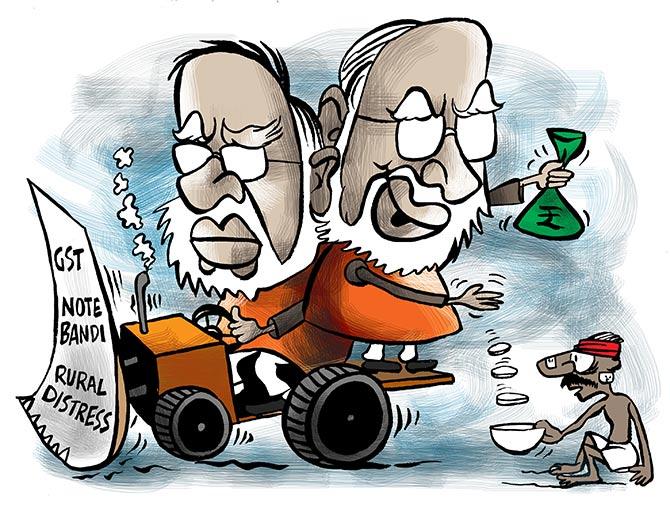 | « Back to article | Print this article |
Spurring the economy, currently in the throes of a slowdown, remains the prime focus for most ministries, but the government is also looking to make women's welfare and environmental protection key to policymaking in this term.

The Union government has decided to focus efforts on the betterment of women, sustainable development, and investment-led economic growth over the next five years.
This emerged from meetings held on January 4, where ministries presented sector-specific plans to Prime Minister Narendra Modi.
Beginning last Friday, the two-day exercise saw 10 sector-specific ministry groupings showcase their plans for enabling development, and initiatives taken over the previous term to the PM and the Council of Ministers.
Spurring the economy, currently in the throes of a slowdown, remains the prime focus for most ministries, but the government is also looking to make women's welfare and environmental protection key to policymaking in this term.
Sources said the Prime Minister’s Office (PMO) held detailed discussions with each sectoral grouping and will soon provide final inputs on ministries’ final vision documents.
Despite these being created just a few weeks before the Budget is tabled in Parliament, budgetary allocations will be made accordingly for every department, a source said.
Rather than hear out each ministry individually, as had been the norm earlier, the PMO pushed for a sectoral approach feeling that more convergence in policies was required, the source said.
Individual secretaries led their overall sectoral groups.
The groupings included commerce, finance, micro, small & medium enterprises (MSME), labour and rural development, among others.
The commerce secretary led the commerce group, which included the departments of Commerce, Heavy Industries, Textiles and the Department for Promotion of Industry and Internal Trade (DPIIT).
The commerce department said credit at lower rates needed to be made available to exporters, and MSMEs, especially, as the sector faces a liquidity crisis.
Providing a robust export promotion regime, with schemes that are compliant with global rules also ranks high on the department's plans.
It also suggested continuing bilateral discussions with major partner countries to explore export opportunities, including the United States and European Union.
This comes at a time when rising global protectionism has pushed most nations to increasingly trade within their regional or multilateral blocs.
A broad-based decline in major revenue earners like textiles, engineering goods and gems have meant that India’s exports have fallen for four straight months till November.
More worryingly, imports contracted for the sixth straight month, driven by petroleum, engineering and industrial items, an indicator of sustained demand slowdown in the economy.
Interestingly, the Ministry of External Affairs (MEA), which was also part of the commerce grouping, argued for a stronger role in ongoing bilateral trade negotiations, a senior official said.
The MEA has in turn been advised by the PMO to work in tandem with the DPIIT to galvanise foreign direct investment through India's diplomatic missions abroad, he added.
Creation of an e-commerce policy and an industrial policy, both of which have crossed multiple deadlines, are integral to the DPIIT’s plans to boost both domestic industry and the retail sector.
Work on both these policies would be expedited, it informed the PMO.
DPIIT also aims to improve India’s ease of doing business at the local level and has said it will partner with states and other government bodies.
Measures to create a single window platform for investors are currently underway, another official said.
Official data show contraction remained entrenched in the manufacturing sector till November.
India’s overall industrial production fell 3.8 per cent in October, after an eight-year high contraction of 4.3 per cent in September.
The output of eight core sectors of the economy, too, fell for a third straight month in November, contracting 1.5 per cent.